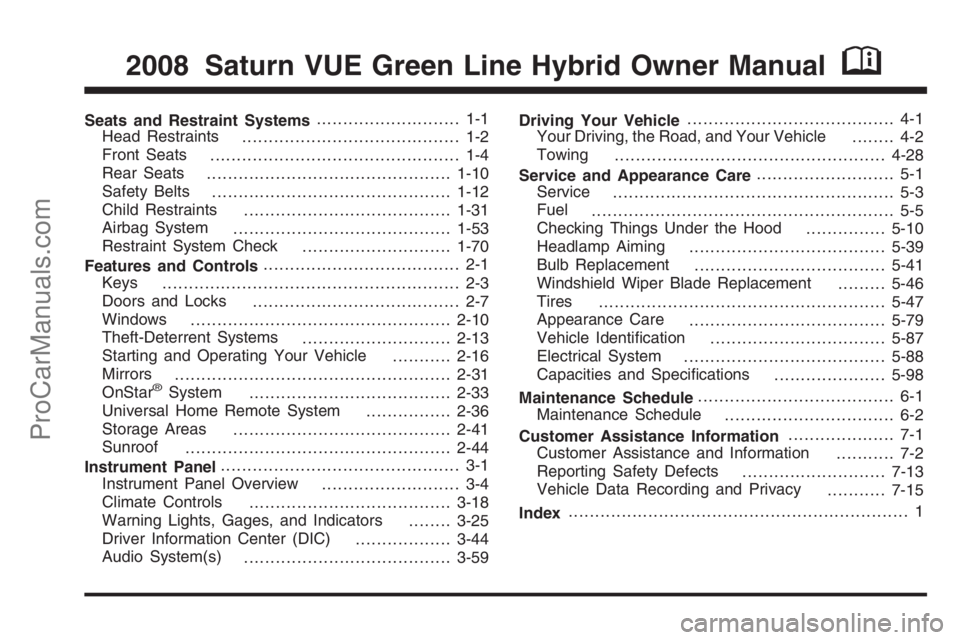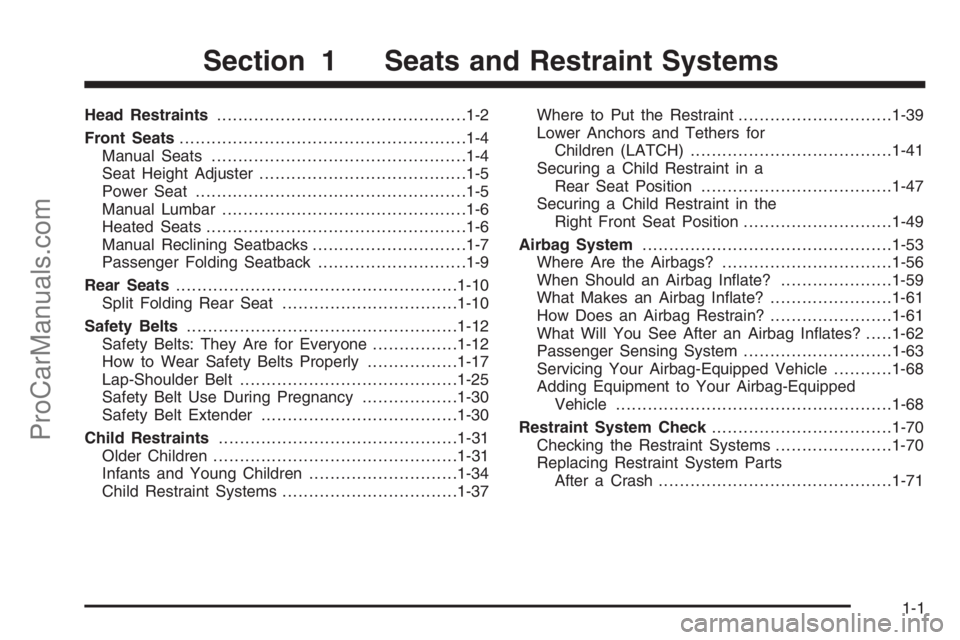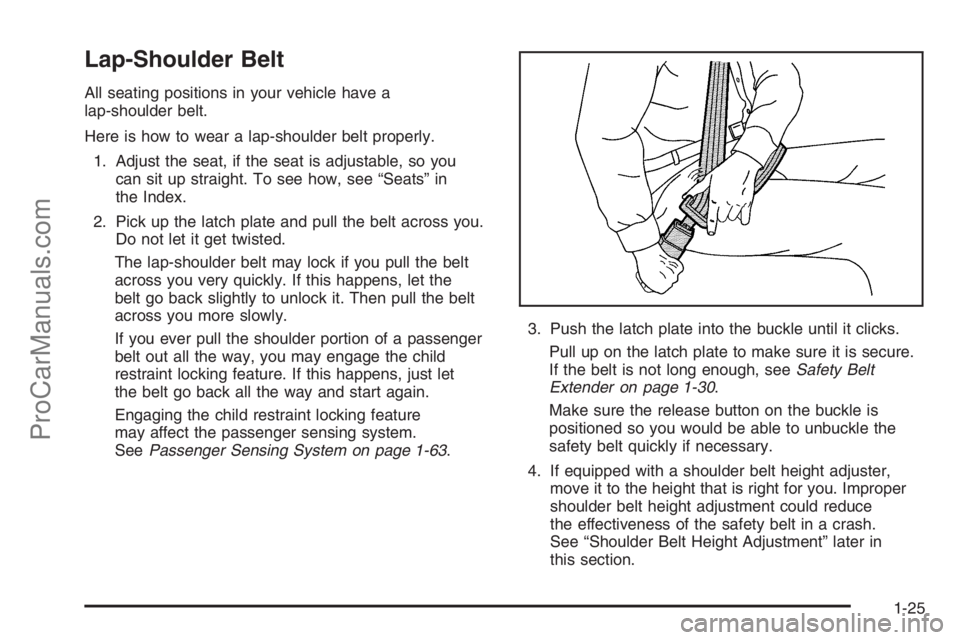child restraint SATURN VUE HYBRID 2008 Owners Manual
[x] Cancel search | Manufacturer: SATURN, Model Year: 2008, Model line: VUE HYBRID, Model: SATURN VUE HYBRID 2008Pages: 384, PDF Size: 2.56 MB
Page 1 of 384

Seats and Restraint Systems........................... 1-1
Head Restraints
......................................... 1-2
Front Seats
............................................... 1-4
Rear Seats
..............................................1-10
Safety Belts
.............................................1-12
Child Restraints
.......................................1-31
Airbag System
.........................................1-53
Restraint System Check
............................1-70
Features and Controls..................................... 2-1
Keys
........................................................ 2-3
Doors and Locks
....................................... 2-7
Windows
.................................................2-10
Theft-Deterrent Systems
............................2-13
Starting and Operating Your Vehicle
...........2-16
Mirrors
....................................................2-31
OnStar
®System
......................................2-33
Universal Home Remote System
................2-36
Storage Areas
.........................................2-41
Sunroof
..................................................2-44
Instrument Panel............................................. 3-1
Instrument Panel Overview
.......................... 3-4
Climate Controls
......................................3-18
Warning Lights, Gages, and Indicators
........3-25
Driver Information Center (DIC)
..................3-44
Audio System(s)
.......................................3-59Driving Your Vehicle....................................... 4-1
Your Driving, the Road, and Your Vehicle
........ 4-2
Towing
...................................................4-28
Service and Appearance Care.......................... 5-1
Service
..................................................... 5-3
Fuel
......................................................... 5-5
Checking Things Under the Hood
...............5-10
Headlamp Aiming
.....................................5-39
Bulb Replacement
....................................5-41
Windshield Wiper Blade Replacement
.........5-46
Tires
......................................................5-47
Appearance Care
.....................................5-79
Vehicle Identi�cation
.................................5-87
Electrical System
......................................5-88
Capacities and Speci�cations
.....................5-98
Maintenance Schedule..................................... 6-1
Maintenance Schedule
................................ 6-2
Customer Assistance Information.................... 7-1
Customer Assistance and Information
........... 7-2
Reporting Safety Defects
...........................7-13
Vehicle Data Recording and Privacy
...........7-15
Index................................................................ 1
2008 Saturn VUE Green Line Hybrid Owner ManualM
ProCarManuals.com
Page 5 of 384

Head Restraints...............................................1-2
Front Seats......................................................1-4
Manual Seats................................................1-4
Seat Height Adjuster.......................................1-5
Power Seat...................................................1-5
Manual Lumbar..............................................1-6
Heated Seats.................................................1-6
Manual Reclining Seatbacks.............................1-7
Passenger Folding Seatback............................1-9
Rear Seats.....................................................1-10
Split Folding Rear Seat.................................1-10
Safety Belts...................................................1-12
Safety Belts: They Are for Everyone................1-12
How to Wear Safety Belts Properly.................1-17
Lap-Shoulder Belt.........................................1-25
Safety Belt Use During Pregnancy..................1-30
Safety Belt Extender.....................................1-30
Child Restraints.............................................1-31
Older Children..............................................1-31
Infants and Young Children............................1-34
Child Restraint Systems.................................1-37Where to Put the Restraint.............................1-39
Lower Anchors and Tethers for
Children (LATCH)......................................1-41
Securing a Child Restraint in a
Rear Seat Position....................................1-47
Securing a Child Restraint in the
Right Front Seat Position............................1-49
Airbag System...............................................1-53
Where Are the Airbags?................................1-56
When Should an Airbag In�ate?.....................1-59
What Makes an Airbag In�ate?.......................1-61
How Does an Airbag Restrain?.......................1-61
What Will You See After an Airbag In�ates?.....1-62
Passenger Sensing System............................1-63
Servicing Your Airbag-Equipped Vehicle...........1-68
Adding Equipment to Your Airbag-Equipped
Vehicle....................................................1-68
Restraint System Check..................................1-70
Checking the Restraint Systems......................1-70
Replacing Restraint System Parts
After a Crash............................................1-71
Section 1 Seats and Restraint Systems
1-1
ProCarManuals.com
Page 29 of 384

Lap-Shoulder Belt
All seating positions in your vehicle have a
lap-shoulder belt.
Here is how to wear a lap-shoulder belt properly.
1. Adjust the seat, if the seat is adjustable, so you
can sit up straight. To see how, see “Seats” in
the Index.
2. Pick up the latch plate and pull the belt across you.
Do not let it get twisted.
The lap-shoulder belt may lock if you pull the belt
across you very quickly. If this happens, let the
belt go back slightly to unlock it. Then pull the belt
across you more slowly.
If you ever pull the shoulder portion of a passenger
belt out all the way, you may engage the child
restraint locking feature. If this happens, just let
the belt go back all the way and start again.
Engaging the child restraint locking feature
may affect the passenger sensing system.
SeePassenger Sensing System on page 1-63.3. Push the latch plate into the buckle until it clicks.
Pull up on the latch plate to make sure it is secure.
If the belt is not long enough, seeSafety Belt
Extender on page 1-30.
Make sure the release button on the buckle is
positioned so you would be able to unbuckle the
safety belt quickly if necessary.
4. If equipped with a shoulder belt height adjuster,
move it to the height that is right for you. Improper
shoulder belt height adjustment could reduce
the effectiveness of the safety belt in a crash.
See “Shoulder Belt Height Adjustment” later in
this section.
1-25
ProCarManuals.com
Page 35 of 384

Child Restraints
Older Children
Older children who have outgrown booster seats should
wear the vehicle’s safety belts.The manufacturer’s instructions that come with the
booster seat state the weight and height limitations for
that booster. Use a booster seat with a lap-shoulder
belt until the child passes the below �t test:
Sit all the way back on the seat. Do the knees
bend at the seat edge? If yes, continue.
If no, return to the booster seat.
Buckle the lap-shoulder belt. Does the shoulder
belt rest on the shoulder? If yes, continue.
If no, try using the rear safety belt comfort guide.
See “Rear Safety Belt Comfort Guides” under
Lap-Shoulder Belt on page 1-25for more
information. If the shoulder belt still does not rest
on the shoulder, then return to the booster seat.
Does the lap belt �t low and snug on the hips,
touching the thighs? If yes, continue.
If no, return to the booster seat.
Can proper safety belt �t be maintained for
the length of the trip? If yes, continue.
If no, return to the booster seat.
1-31
ProCarManuals.com
Page 36 of 384

Q:What is the proper way to wear safety belts?
A:An older child should wear a lap-shoulder belt and
get the additional restraint a shoulder belt can
provide. The shoulder belt should not cross the face
or neck. The lap belt should �t snugly below the
hips, just touching the top of the thighs. This applies
belt force to the child’s pelvic bones in a crash.
It should never be worn over the abdomen, which
could cause severe or even fatal internal injuries
in a crash.
Also see “Rear Safety Belt Comfort Guides” under
Lap-Shoulder Belt on page 1-25.
According to accident statistics, children and infants
are safer when properly restrained in the rear seating
positions than in the front seating positions.
In a crash, children who are not buckled up can strike
other people who are buckled up, or can be thrown
out of the vehicle. Older children need to use safety
belts properly.{CAUTION:
Never do this.
Here two children are wearing the same belt.
The belt cannot properly spread the impact
forces. In a crash, the two children can be
crushed together and seriously injured. A belt
must be used by only one person at a time.
1-32
ProCarManuals.com
Page 38 of 384

Infants and Young Children
Everyone in a vehicle needs protection! This includes
infants and all other children. Neither the distance
traveled nor the age and size of the traveler changes
the need, for everyone, to use safety restraints.
In fact, the law in every state in the United States
and in every Canadian province says children up to
some age must be restrained while in a vehicle.
{CAUTION:
Children can be seriously injured or strangled
if a shoulder belt is wrapped around their
neck and the safety belt continues to tighten.
Never leave children unattended in a vehicle
and never allow children to play with the
safety belts.Every time infants and young children ride in vehicles,
they should have the protection provided by appropriate
restraints. Children who are not restrained properly
can strike other people, or can be thrown out of
the vehicle. In addition, young children should not
use the vehicle’s adult safety belts alone; they need
to use a child restraint.
{CAUTION:
People should never hold an infant in their
arms while riding in a vehicle. An infant does
not weigh much — until a crash. During a
crash an infant will become so heavy it is
not possible to hold it. For example, in a
crash at only 25 mph (40 km/h), a 12 lb (5.5 kg)
infant will suddenly become a 240 lb (110 kg)
force on a person’s arms. An infant should
be secured in an appropriate restraint.
1-34
ProCarManuals.com
Page 39 of 384

{CAUTION:
Children who are up against, or very close to,
any airbag when it in�ates can be seriously
injured or killed. Airbags plus lap-shoulder belts
offer protection for adults and older children,
but not for young children and infants.
CAUTION: (Continued)
CAUTION: (Continued)
Neither the vehicle’s safety belt system nor
its airbag system is designed for them. Young
children and infants need the protection that
a child restraint system can provide.
1-35
ProCarManuals.com
Page 40 of 384

Q:What are the different types of add-on child
restraints?
A:Add-on child restraints, which are purchased by the
vehicle’s owner, are available in four basic types.
Selection of a particular restraint should take
into consideration not only the child’s weight, height,
and age but also whether or not the restraint will
be compatible with the motor vehicle in which it
will be used.
For most basic types of child restraints, there are
many different models available. When purchasing
a child restraint, be sure it is designed to be
used in a motor vehicle. If it is, the restraint will
have a label saying that it meets federal motor
vehicle safety standards.
The restraint manufacturer’s instructions that
come with the restraint state the weight and
height limitations for a particular child restraint.
In addition, there are many kinds of restraints
available for children with special needs.
{CAUTION:
Newborn infants need complete support,
including support for the head and neck.
This is necessary because a newborn infant’s
neck is weak and its head weighs so much
compared with the rest of its body. In a crash,
an infant in a rear-facing seat settles into
the restraint, so the crash forces can be
distributed across the strongest part of an
infant’s body, the back and shoulders.
Infants should always be secured in
appropriate infant restraints.
1-36
ProCarManuals.com
Page 41 of 384

{CAUTION:
The body structure of a young child is quite
unlike that of an adult or older child, for whom
the safety belts are designed. A young child’s
hip bones are still so small that the vehicle’s
regular safety belt may not remain low on the
hip bones, as it should. Instead, it may settle
up around the child’s abdomen. In a crash,
the belt would apply force on a body area
that is unprotected by any bony structure.
This alone could cause serious or fatal injuries.
Young children should always be secured in
appropriate child restraints.
Child Restraint Systems
A rear-facing infant
seat (A) provides
restraint with the
seating surface
against the back
of the infant.
The harness system holds the infant in place and,
in a crash, acts to keep the infant positioned in
the restraint.
A forward-facing child
seat (B) provides
restraint for the child’s
body with the harness.
1-37
ProCarManuals.com
Page 42 of 384

A booster seat (C-D) is a child restraint designed to
improve the �t of the vehicle’s safety belt system.
A booster seat can also help a child to see out
the window.
Securing an Add-On Child Restraint
in the Vehicle
{CAUTION:
A child can be seriously injured or killed in
a crash if the child restraint is not properly
secured in the vehicle. Make sure the child
restraint is properly installed in the vehicle
using the vehicle’s safety belt or LATCH
system, following the instructions that came
with that restraint, and also the instructions
in this manual.
1-38
ProCarManuals.com